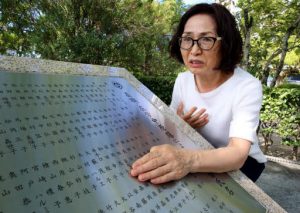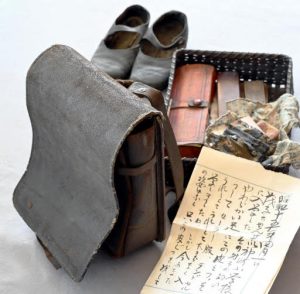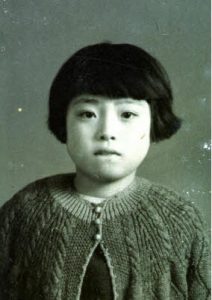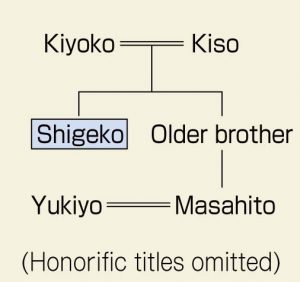Striving to fill voids in Hiroshima, evidence of victims remains 76 years after atomic bombing—First Girls’ School victim’s family considers donating backpack to pass on memory to next generations
Jul. 7, 2021
“Overjoyed to start school”
by Junji Akechi, Staff Writer
Shigeko Maeoka, then 12, died in the atomic bombing when she was in her first year at Hiroshima First Municipal Girls’ School (First Girls’ School; now Funairi High School). Her mother Kiyoko, then 41, held on to the backpack Shigeko used when she was a child, storing it as a personal keepsake in the absence of her daughter’s remains. “I want to hold onto her memory for her.” On August 6 this year, Yukiyo, 67, the wife of Kiyoko’s grandson who lives in Hiroshima’s Naka Ward, offered flowers to the memorial for the students and teachers at First Girls’ School who died in the atomic bombing, vowing to pass on the memory of the mother and child torn apart by the bombing.
A small backpack’s leather is worn in places, revealing a brownish tint under its original black color. It is thought to have been purchased when Shigeko was to start elementary school. The item is accompanied by a letter from Kiyoko to her deceased daughter written 20 years after the atomic bombing. “You were overjoyed to start school, wearing your sailor uniform and backpack,” the letter reads. “I sometimes take out the keepsake and just weep.”
On August 6, 1945, a total of 541 first- and second-year students from First Girls’ School were mobilized to demolish homes for the creation of fire lanes south of what is now Hiroshima Peace Memorial Park, in the city’s Naka Ward. All were killed when the U.S. military dropped the bomb. Kiyoko herself experienced the bombing at their home in the area of Enkobashi-cho (now part of Minami Ward). She survived the blast but could not move at the time due to serious wounds she suffered. Her husband, Kiso, searched for their daughter but was unable to find even her remains.
In a publication titled Ryuto (Floating lantern, in English), which is comprised of a collection of essays published in 1957 by bereaved families of First Girls’ School victims, Kiyoko wrote: “The situation didn’t even allow the parents to be present at their children’s deaths.” The essay continued, “I will apologize, apologize, and apologize to her as long as I’m alive.” Her three-page account is filled with resentment and regret that she was unable to save her daughter.
Yukiyo married Kiyoko’s grandson, Masahito, in 1982, and the couple were blessed with three daughters. Yukiyo’s grandmother-in-law seemed to have constant feelings of guilt. With the regret of not having been able to feed her daughter sufficiently, she always urged Masahito and her great-grandchildren to eat more. After Kiyoko passed away in 1990, Masahito continued to attend an annual memorial service for her. However, after his sudden death last year in December at the age of 72, Yukiyo decided to attend the memorial service starting this year, with the idea that participation is the “role of those left behind.”
She is considering the donation of Shigeko’s personal belongings to the Hiroshima Peace Memorial Museum (located in the city’s Naka Ward), given that they have deteriorated over time. “Our descendants can learn about Shigeko as long as the belongings can be kept at the museum. I’m sure my grandmother-in-law would be happy about it.” Choked up with tears, Yukiyo gently stroked Shigeko’s name inscribed on the memorial tablet standing behind the First Girls’ School A-bomb monument.
(Originally published on August 7, 2021)











